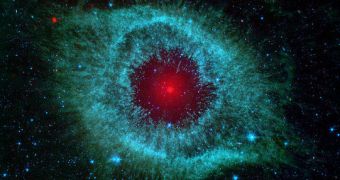Rochester Institute of Technology (RIT) expert and post-doctoral research scientist Dan Dicken is one of the experts whose main area of interest is discovering the origins of infrared emissions that come from powerful, distant, active galactic nuclei. In order to get a comprehensive view of the subject, he is to soon begin a massive data-mining experiment, which will take him through all the massive data sets collected by NASA's Spitzer Space Telescope, one of the space agency's Great Observatories.
Common astronomical knowledge at this point has it that active galactic nuclei, AGN for short, are powered by impressive, supermassive black holes at their cores. As stars and other types of interstellar objects and matter get trapped within the immense gravitational fields that these dark behemoths create, they are pulled and torn apart, giving birth to vast amounts of energy and radiation in the process. The latter shines in large segments of the electromagnetic spectrum, but is highly visible in infrared.
“What makes active galactic nuclei so special is they are incredibly bright galaxies – the brightest – not only at optical wavelengths, but at all wavelengths from radio all the way through to X-rays. This means they can be seen at very large distances and are, consequently, important for the evolution of the Universe. Like infrared cameras on earth, infrared astronomy views the universe at wavelengths we associate with heat energy. We can't see infrared wavelengths, but we can feel them as heat from things like radiators,” Dicken reveals.
The reason why data from Spitzer will be used in the new investigations is the fact that the telescope has just finished its cold mission in May, when its coolant ran out. “The great power of infrared astronomy is that it's not obscured like optical astronomy. You can see the heat energy from the central source. You can see through the dust,” the expert explains. Though he has only had his doctorate degree for six months, he has already been awarded a $100,000 grant by NASA. The funds should be sufficient to allow him to peer through the archives and to employ a student assistant in doing so.
“Winning such a prestigious award at the beginning of my career as an astronomer is phenomenal for me. And it serves to show that if you have the backing of such an experienced team, such as the staff and faculty at RIT, you can really turn a good idea into a full-sized science project. The big question I'd like to answer is to determine the proportion of starbursts to active galactic nuclei heating of dust and gas in distant AGN,” Dicken concludes.

 14 DAY TRIAL //
14 DAY TRIAL //